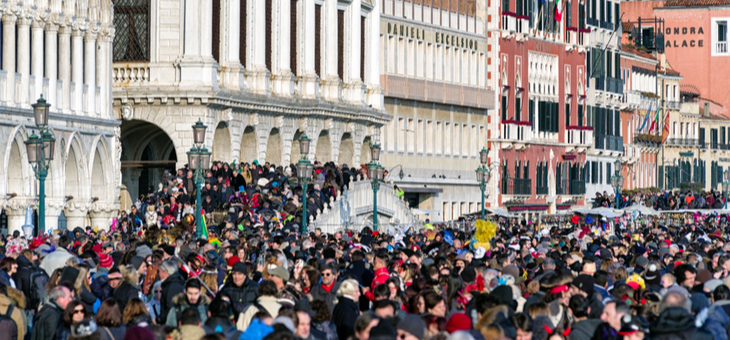I used to live on the Mornington Peninsula. The number of people who call the Mornington Peninsula home totals around 145,000 and yet the region (as a whole) accepts more than 7.6 million visitors each year.
Suffice to say, it takes a lot longer to get around in summer, longer to buy a six-pack at the bottle shop and longer still to do the weekly shop at the supermarket. Eating out over summer? Forget about it. While a coastal region typically lends itself to warmer weather, my favourite time of year was winter. Fewer tourists make happy locals. I moved to the city to get away from the crowds.
I can sympathise with popular destinations having to deal with similar swelling populations, being overrun by tourists who make daily life more difficult.
People living in Amsterdam, Barcelona and other overcrowded destinations are seeing tourists pour in at unprecedented rates, with some cities close to breaking point. In fact, in Venice and Amsterdam, tourism boards are doing their darndest to dissuade tourism.
Amsterdam has a population of around 830,000, and the city receives over 5.3 million tourists per year.
“Amsterdam’s residents feel like their city is taken away from them; their tolerance is becoming thinner and they feel almost chased away to more peaceful areas,” Dana Marin, a writer for Amsterdamian.com told Smarter Travel.
“Amsterdam was already a densely populated place, now it’s becoming overcrowded. The quality of the residential areas has been affected by the short-term rentals (it’s not nice to have someone who throws a party every night when you have to go to work the next day). The local shops are being closed to make space for souvenir shops and pancake places. It’s more difficult to find a place in a bar or a restaurant, and not only on weekend nights. When I look for a place to go out, I try to avoid the centre and so do most of my friends.”
Venice is home to around 55,000 locals and yet the city sees a staggering 30 million tourists every year.
There used to be a low season for locals, but “Nowadays, there’s no low season: tourists come all year long in massive groups,” says long-time Venice local Sara.
“It’s hard and stressful to walk around the city … ferry boats, trains, buses and trams are always packed with people, the parking lots are always full. Even if you’re a resident you have to pay just to present an application form for a parking spot that it is very expensive, and you have to keep your fingers crossed on a waiting list that can take years. I have a friend that has been waiting for 10 years. And prices are booming: tickets, fees, taxes, goods, houses, transportation.”
While the residents may not like it, their communities feed off tourism. There’s a fine line between turning tourists away and turning them off entirely.
Tourism boards are trying to manage this by spreading the love and sending people away from ‘honey-pot’ destinations. So, instead of promoting city centres, tourism authorities are highlighting outer regions, hinterlands and iconic locations away from the CBD and tourist hotspots.
“Pressure on the liveability of our cities, regions and iconic locations will increase due to increasing visitor numbers, while other parts of the Netherlands do not or insufficiently benefit from the opportunities and socio-economic boost tourism can offer,” says Antonia Koedijk, director, North America, Netherlands Board of Tourism and Conventions.
Barcelona has also put in place rules to block tourism, limiting construction of new hotels and enforcing strict rules on visiting tourists.
Venice is proposing an entry tax of $11 for day visitors, which would charge tourists approximately A$15.
The locals know their cities are popular for a reason, they’d just like a little respect.
“Remember they are visiting a city where people live, work and raise children, like everywhere else …Try to not make noise on the streets during the night, don’t use the stairs of the beautiful entrances as open-air bars, don’t destroy the gardens and, if you stay in a rental, be respectful to the other people living in the building,” says Amsterdam resident Dana.
“Venice is a piece of jewellery, it’s a tiny place to live and simply can’t cope with massive numbers of tourists. It is a fragile place,” says Venice local Sara.
“Be respectful, walk on the right-hand side, cross bridges on the right, don’t stop on them to take pics for ages, use garbage bins, drink and eat in local bars or restaurants, don’t sit down everywhere, it’s not a campsite. It has a millenary history, again it is an open-air piece of art. Don’t pee in the canals, use public restrooms or go to a bar. Respect and be curious about the local people, take your time to talk to them. You can’t appreciate Venice’s beauty in a day or two.”
Have you ever spared a thought for the locals who live in popular tourist destinations?
If you enjoy our content, don’t keep it to yourself. Share our free eNews with your friends and encourage them to sign up.
Related articles:
Overtourism: Is there a better way?
How to be a responsible traveller
When is shoulder season?

